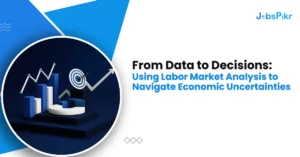We have seen the hue and cry around football transfers or NBA signings. In today’s data-driven corporate industry, there’s just as much chaos and hype involved in the talent sector. Companies are not only finding it difficult to get the appropriate talent but are also unable to retain key personnel who are frequently poached by competitors.
While the talent team in many companies have moved to an automated or semi-automated setup, what matters is whether the right data is being used to make important decisions. This data can mainly be extracted from two sources-
- Market Insights
- Competitor Job Data
Market Insights involves the collection of job market data or Competitor Job Data and delving deep into it to find nuances and trends that may not be easily visible to the naked eye. The data may need to be viewed from different angles to learn more about market conditions.
For instance, hiring trends can make more sense when you combine job market data with other data sources like the stock market, GDP growth, government policies, and more. On the other hand, you may run a Machine Learning Algorithm on a data set and break down the data into individual points and gather job profiles requiring similar skillsets together.
Competitor Job Data may not be as easy to collect or analyse as compared to Job Market Data but may be very useful if you are a mid-size or a large company. Managing a large and diverse workforce and adding to it may be difficult without keeping a tab on what your competitors are up to. Benchmarking your data against your competitors can also ensure that you are not falling behind in any parameter. Data points like skillsets asked for, compensations and benefits offered, and work-location flexibility are some of the data points which companies use for comparison.
The benefits of building a data-driven talent strategy
Market data and competitor information combined with your internal data can make a lot of processes quicker and more efficient by removing human interference and bias. This would enable you to process more people at the same time and have a leaner people-management team.
Some notable benefits of using Competitor Job Data to your advantage are:
Finding individuals for key vacancies or positions that need a specific skillset
Niche positions requiring candidates with specific skillsets such as deep technical knowledge or those where one may need to wear multiple hats may be difficult to fill. Having Competitor Job Data will help you find candidates who are currently working in similar positions and pull them into your team. A market study may also help in finding which portals such job posts are usually advertised in.
Figuring out the different talent acquisition strategies used
In recent years, companies have begun advertising on multiple mediums, even buses and billboards. Some companies don’t spend a penny on marketing but instead maintain an outstanding relationship with their employees thus making every employee a part of their marketing team. Such companies see higher referrals and applications from experienced individuals who want to work with a team having a good work-culture. It is upto you to learn from your competitors and decide on what works best for you.
Deciding where to open your next office
Client location may not be the only deciding factor when you decide to open your next office. Today companies all over the world are opening offices in areas where there is a high concentration of talent such as Bangalore. Given that the city is also a hub for technology and innovation makes the deal even sweeter.
In this regard, you can use both market insights to figure out where companies are setting up their tech, sales, or finance team and Competitor Job Data to find out which locations they are hiring for. Certain positions may also see more remote options- which you will have to uncover using the data at hand.
Gain insights into how your company compares to others
As a company you need to ensure that you are hiring the right candidate, giving him or her reasonable benefits and remuneration and maintaining a low attrition rate. Unless you have Competitor Job Data to compare with, all three tasks mentioned above may be difficult to implement.
Let’s start with the job listing. Job posts with the skillset requirement of an entire team and not just an individual are common. Such posts either see fewer applicants or applicants who don’t fit the requirements. Hence, you may need to crunch the Competitor Job Data and look at advertisements for similar positions and compare the requirements that you want to share against the market standards first. This would ensure that you get more applicants and also spend less time weeding out those that don’t fit.
Salary comparison is another job for which the talent team has to use Competitor Job Data. This data will not only help you offer the right compensation to candidates who join your organization but will also enable you to retain important employees by standardizing their salary based on market rates from time to time.
Keep a tab on the movement of Competitor Job Data
In recent months, quite a few tech companies have laid off thousands of employees in key regions like India and the US. For companies who are in a hiring mode, this information may be valuable. There are skilled folks from brands like Google, Amazon and Spotify who are looking for jobs. Some individuals have led important teams for decades. This may be a once-in-a-lifetime opportunity for many small companies to tap into this moment.
This is just an example of how keeping track of the talent flow can help you. While the given example is a global phenomenon you would also need to keep track of smaller events which impact the workforce.
Strengthen Employer Branding
Remuneration, job role, work culture, Glassdoor reviews, and added benefits are all great, but unless you are branded as a good employer, you may have a hard time attracting top talent. The size of a company is immaterial here since employer branding has all to do with how you handle talent and not how large your headcount is.
The biggest online stock broker in India currently has a tech team of just 33 employees and has had only 2 resignations till date. This takes their company to the dream list for many top developers. Such employer branding takes time to build. But with the right Competitor Job Data and by learning from your competitors, you still stand a chance.
Improve the hiring workflow
Once you have all the Competitor Job Data numbers with you, you will also need to get internal data related to:
- Attrition details- Attrition rates change based on market conditions and sectoral growth. Sectors like tech, professional services and entertainment usually see a higher churn rate while others like government admin jobs see the lowest turnover. On top of the usual figures, external events can also impact employee behaviour. For example, Covid increased the demand for skilled software developers which caused many to seek out better opportunities.
Likewise, as the digital boom boosted by Covid came to an end, companies started laying off extra employees and attrition rates have fallen since. As you decide the people’s strategy for your company, you need to be aware of all these factors to ensure that you do not face a sudden fall in headcount.
- Hiring timelines- Hiring timelines usually have a massive impact on how prospective candidates behave. A longer timeline with major roadblocks may see a large percentage of those entering your hiring funnel drop out. In this case, too, you will need to use Competitor Job Data to ensure that your average hiring timeline remains below the industry average.
- Promotions and Salary Revisions- Long-term employees often quit their jobs in search of more lucrative options. This can be due to:
- Not getting hikes on time
- Delayed promotions
- New joiners getting better salaries based on market standards
This is why it may be imperative to keep track of your most vital employees and ensure that they are fairly treated and compensated in line with your competition.
- Performance reviews as well as reverse reviews- Timely performance reviews not only help reward and recognize those putting in their best efforts but also enable individuals to understand where they might be going wrong and how to improve. Reverse reviews for managers on the other hand can help weed out problems like micromanagement, favouritism or other unfair practices that may affect the work environment.
Where can you get the Competitor Job Data?
No matter what use you put the data to, getting the data in a clean format should be your first goal. This is where JobsPikr comes in. Using data provided by us in the form of a real-time stream, you can perform job market analysis and build your talent intelligence system which will enable you to make data-backed talent decisions. Some of the common use of our data is:
- Location Assessment
- Discovery of In-Demand Skills
- Competition Analysis
- Salary Benchmarking
Our services help companies both big and small use job market data to make sense of the dynamic labour force and forecast the talent requirements for tomorrow.



